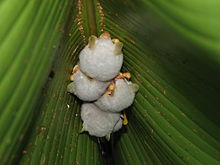Honduran white bat
| Honduran white bat | |
|---|---|
 |
|
| Honduran white bat Ectophylla alba |
|
| Scientific classification | |
| Kingdom: | Animalia |
| Phylum: | Chordata |
| Class: | Mammalia |
| Order: | Chiroptera |
| Family: | Phyllostomatidae |
| Genus: |
Ectophylla H. Allen, 1892 |
| Species: | E. alba |
| Binomial name | |
|
Ectophylla alba (H. Allen, 1892) |
|
The Honduran white bat (Ectophylla alba) has snow white fur and a yellow nose and ears. It is tiny, only 3.7-4.7 cm long. The only member of the genus Ectophylla, it is found in Honduras, Nicaragua, Costa Rica and western Panama at elevations from sea level to 700 m. It feeds at least in part on fruit.
The Honduran white bat cuts the side veins extending out from the midrib of the large leaves of the Heliconia plant causing them to fold down to form a 'tent'. They cling to the roof of this tent in small colonies of up to half a dozen individuals, consisting of one male and a harem of females. The tent protects them from rain and predators. Most tent-making bats (such as the aptly named tent-making bat) take flight at even slight disturbances, but researchers in Costa Rica have reported that Honduran white bats take flight only when the main stem of their tent is disturbed, possibly because they are well camouflaged. Although their tents are typically low to the ground (about six feet), sunlight filters through the leaf which gives their white fur a greenish cast. This almost completely conceals them if they remain still. It has been suggested a colony may have a number of tents scattered within the forest. It is one of 15 species of Latin American bats that roost in tents. In the Old World, 3 species of bat from India and Southeast Asia are known to roost in tents.
The Honduran white bat (Ectophylla alba) is a bat that has – like its name suggests – snow white to grayish fur, along with an amber or yellow nose and ears. They are a near-threatened species of bat and are up for re-evaluation in the near future under the new standards of the IUCN. This bat, along with three Diclidurus are the only currently known species of bat where the pelage is all white. Most other bats species are a variant of brown, tan, or might have white markings in the case of the recently discovered Mindoro stripe-faced fruit bat. The bats are rather small in size, measuring at just 1–2 in (2.5–5.1 cm) in length and the weight is about up to 0.2 oz (6 g).
...
Wikipedia

